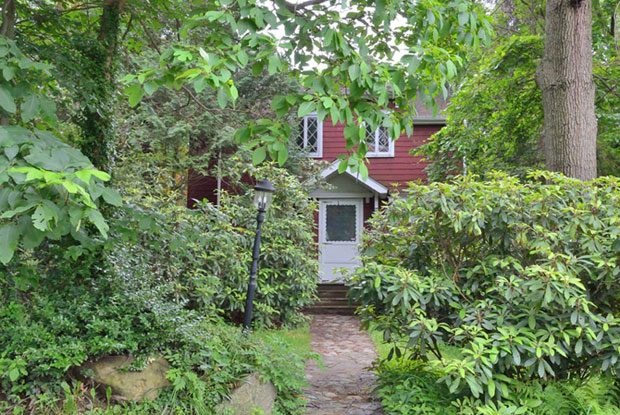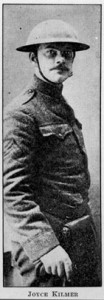
It took Joyce Kilmer only 12 lines of poetry to make a permanent mark on the literary world. “Trees,” a simple tribute to nature’s beauty, earned the New Jersey native a national following upon its publication 100 years ago this month.
Despite Kilmer’s lasting fame, he is often mistaken for a she—thanks to a feminine first name. What’s more, few realize that Kilmer was a decorated war hero, killed in action in France just five years after “Trees” vaulted him to national prominence.
Born Alfred Joyce Kilmer in New Brunswick on December 6, 1886, Kilmer was the fourth child in a prominent New Jersey family. His father, Dr. Frederick Barnett Kilmer, was a pharmacist, analytical chemist and director of scientific affairs for Johnson & Johnson. The senior Kilmer was already well known for his work Modern Methods of Antiseptic Wound Treatment, a staple in hospitals, but his career skyrocketed after he invented baby powder, which launched in 1893.
The younger Kilmer attended Rutgers College (now Rutgers University) from 1904 to 1906, ultimately receiving his Bachelor of Arts degree from Columbia University in 1908. He taught Latin, English and algebra for a year at Morristown High School and then moved to New York City to freelance and work on the 1912 edition of The Standard Dictionary. He dropped his first name and became Joyce Kilmer almost immediately, publishing work under his shortened name in the New York Times, the Literary Digest, Town & Country and The Nation.
Kilmer married and soon made plans to move out of the city with his wife, the former Aline Murray, and their first son, Kenton. On July 8, 1911, Kilmer wrote to his mother that he had purchased a lot for a new house in the undeveloped Cragmere Park section of Mahwah. The densely wooded area was ideal for a commuter seeking refuge from the concrete confines of crowded Manhattan.
In 1912, the family moved into a small white house at 162 Airmount Road. A large boulder rested prominently in the front yard; behind the house was a glorious stand of trees that would inspire Kilmer as he wrote in his upstairs office. Kilmer’s desk faced a window that “looked down on a hill, on our well-wooded lawn—trees of many kinds, from mature trees to thin saplings; oaks, maples, black and white birches and I don’t know what else,” wrote Kenton in his book Memories of My Father, Joyce Kilmer, published in 1933.
On February 2, 1913, Kilmer, working at his upstairs desk, composed 12 lines on the beauty of trees:
I think that I shall never see
A poem lovely as a tree.
A tree whose hungry mouth is prest
Against the earth’s sweet flowing breast;
A tree that looks at God all day,
And lifts her leafy arms to pray;
A tree that may in Summer wear
A nest of robins in her hair;
Upon whose bosom snow has lain;
Who intimately lives with rain.
Poems are made by fools like me,
But only God can make a tree.
Published that August in Poetry: A Magazine of Verse and reprinted in Kilmer’s first book, Trees and Other Poems, in 1914, “Trees” rapidly gained national attention. “I think Joyce Kilmer was surprised as anybody that this poem caught fire around the world,” says Kilmer expert Alex Michelini, founder of the Joyce Kilmer Society of Mahwah. Michelini says trees and jungles were a rising literary theme at the time, as exemplified by the tree-swinging character Tarzan, who had just been introduced by writer Edgar Rice Burroughs in 1912.
In the ensuing years, Kilmer’s reputation as a writer and editor continued to grow. On his daily walks to the express train in Suffern, Kilmer would pass an abandoned house that became the inspiration for another celebrated poem, “The House with Nobody In It.” He became the poetry editor of Current Literature and contributing editor of Warner’s Library of the World’s Best Literature, and published six collections of poetry and essays.

Courtesy of Miriam Kilmer
Then in 1917, the United States entered World War I, which had been raging in Europe since 1914. The government implemented a draft, but Kilmer, like others drawn to the patriotic cause, volunteered before being called.
Entering the military as a private with the 7th Regiment of the New York National Guard, Kilmer was transferred to the 69th Infantry Regiment and enthusiastically rose to the rank of sergeant. Just before deploying to France, he signed with a publisher for a book tentatively titled Here and There With the Fighting 69th. It would be a chronicle of his war experiences.
The regiment, also known as the Fighting Irish, was mostly first- and second-generation New York-area Irish immigrants, including the well-known Irish-Catholic chaplain Father Francis Duffy. Kilmer’s morale-boosting poem, “When the 69th Comes Back,” rang of German defeat and Irish-American heroism:
With the Potsdam Palace on a truck and the Kaiser in a sack,
New York will be seen one Irish green when the Sixty-ninth comes back.
God rest our valiant leaders dead, whom we cannot forget;
They’ll see the Fighting Irish are the Fighting Irish yet.
Once overseas, Kilmer gained a reputation for taking on hazardous missions. In July 1918, during the Second Battle of the Marne, he volunteered to replace a soldier killed in fighting on the hills near the Ourcq River. Shortly after he left to scout for a hidden German machine gun, fellow soldiers spotted him leaning over the edge of a hill. Assuming he had crawled to the spot for a better view of the ravine below, they called out to him. When he didn’t respond, they rushed forward to his aid. Kilmer was dead of a single gunshot wound to the head.
Father Duffy, one of the most highly decorated clerics in the history of the U.S. army, was among those who discovered Kilmer’s body. “A bullet had pierced his brain,” Duffy wrote. “His body was carried in and buried by the side of Ames [the lieutenant he replaced in battle]. God rest his dear and gallant soul.” France posthumously honored Kilmer for heroism with the Croix de Guerre.
Kilmer’s death at 31 was a shock back home. “He was probably one of the most famous Americans killed in World War I,” says Michelini. He was survived by four children: Kenton, Michael, Deborah and Christopher. A daughter, Rose, had died of polio in 1917 at age 5.
The Kilmer family house in Mahwah still stands, now painted red and almost hidden by the surrounding trees. The large boulder out front boasts a plaque donated in 1952 by the Women’s Club of Mahwah commemorating the spot as the birthplace of “Trees” and “The House With Nobody In It.”
With its basic rhyme scheme and timeless message, “Trees” is still widely taught to beginner poets. Eight schools across the country are named after Kilmer, with four in New Jersey alone (three elementary schools and one middle school). Several natural sites around the country bear Kilmer’s name, including Joyce Kilmer Park in New Brunswick, the Joyce Kilmer Memorial Tree in Central Park and the Joyce Kilmer Memorial Forest in North Carolina. In a somewhat ironic twist, the Garden State memorializes Kilmer with a sparsely treed service area between exits 8A and 9 on the New Jersey Turnpike near New Brunswick.
Michelini believes the nature-loving message of “Trees” is one of the reasons for its enduring popularity. “It’s a beautiful song about the environment, and man’s living within it and appreciating it,” says the Mahwah resident. How popular is the poem today? According to author and etymologist Mark Forsyth’s Fifty Most Quoted Lines of Poetry, the opening couplet of “Trees” clocks in at number 26 in terms of Google results.
In the years after Kilmer’s death, many places around the state sought to claim Kilmer’s original tree as one of their own. Most famously, the Rutgers University campus in New Brunswick claimed its magnificent 68-foot-tall, 160-year-old white oak was Kilmer’s inspiration. When the mammoth tree fell victim to decay in 1963, a somber party of 200 gathered to watch five men chainsaw it to pieces. “Trees” was read as part of the memorial service, and the university received 18,000 requests for pieces of the tree as keepsakes.
But Rutgers could never prove its white oak was Kilmer’s muse, so the debate continued. The question finally was put to rest this year—thanks to Michelini’s passion to find indisputable evidence that the poem had been penned at 162 Airmount Road.
Michelini, 75, found that evidence at Georgetown University in Washington, D.C., the alma mater of Kilmer’s son Kenton, where his family had donated boxes of rare letters and documents. Michelini travelled to the university in May after receiving permission to view the collection. Among the boxes of uncataloged documents, he found a notebook with the original handwritten copy of “Trees” and a typed letter dated 1929 by Kilmer’s wife, Aline. In the letter, Aline wrote: “The poem, I definitely remember, was written at home, in the afternoon, in the intervals of some writings. The desk was in an upstairs room, by a window looking down a wooded hill.”
February 2 has been officially designated as Joyce Kilmer Day in Mahwah to celebrate the penning of “Trees,” thanks to Michelini’s efforts. “I do think Kilmer was an extraordinary person,” says Michelini. “I like to borrow the phrase, ‘He was someone you wish you could have met.’”

What was the reason for him dropping “Alfred” and going by “Joyce?”